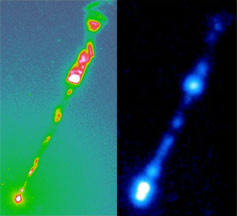
Handy Links
SLAC News Center
SLAC Today
- Subscribe
- Archives: Feb 2006-May 20, 2011
- Archives: May 23, 2011 and later
- Submit Feedback or Story Ideas
- About SLAC Today
SLAC News
Lab News
- Interactions
- Lightsources.org
- ILC NewsLine
- Int'l Science Grid This Week
- Fermilab Today
- Berkeley Lab News
- @brookhaven TODAY
- DOE Pulse
- CERN Courier
- DESY inForm
- US / LHC
SLAC Links
- Emergency
- Safety
- Policy Repository
- Site Entry Form

- Site Maps
- M & O Review
- Computing Status & Calendar
- SLAC Colloquium
- SLACspeak
- SLACspace
- SLAC Logo
- Café Menu
- Flea Market
- Web E-mail
- Marguerite Shuttle
- Discount Commuter Passes
-
Award Reporting Form
- SPIRES
- SciDoc
- Activity Groups
- Library
Stanford
Around the Bay
A Gamma Ray Mystery
 Scattered across the universe, certain galaxies emit enormously powerful jets of relativistic particles intertwined with bursts of gamma rays. Although thousands of these jets have been observed, the precise mechanism by which gamma rays are created has mystified astronomers for more than 15 years. Recently, a team of SLAC scientists made a surprising discovery about the source of the most powerful of these gamma rays that raises as many questions as it answers.
Scattered across the universe, certain galaxies emit enormously powerful jets of relativistic particles intertwined with bursts of gamma rays. Although thousands of these jets have been observed, the precise mechanism by which gamma rays are created has mystified astronomers for more than 15 years. Recently, a team of SLAC scientists made a surprising discovery about the source of the most powerful of these gamma rays that raises as many questions as it answers.
One of the main questions researchers seek to answer about these unique radio galaxies—also known as "blazars" or "quasars" depending on the jet's orientation—is where, exactly, the gamma rays are created. Researchers believe that a black hole at the center of each quasar emits the jet of particles including electrons, positrons and protons. For years they postulated that the gamma rays were created within this jet stream. But later studies led some to believe that the gamma rays were instead produced by a yet unknown physical phenomenon very near the edge of the black hole itself. Now, SLAC researchers Teddy Cheung and Lukasz Stawarz, in collaboration with Daniel Harris at the Harvard-Smithsonian Center for Astrophysics, believe they have finally nailed down the location of gamma ray production.
"It's much farther down the jet than most scientists thought," said Cheung. "It's a very surprising result."
Cheung and his associates recently argued that gamma rays are emanating from a disturbance, or "knot," traveling down the jet flow about 326,200 light years from the central super massive black hole in M87, the only jet close enough to Earth for detailed observation. This places gamma ray production in this galaxy 100 times further from the edge of the black hole than previously believed.
To make this discovery, Cheung and his colleagues used data from four different experiments focusing on different areas of the electromagnetic spectrum; the Hubble Space Telescope observed visible light, the Chandra X-ray Observatory focused on x-rays, the Very Large Array received radio data, and the Very Long Baseline Array scanned the radio spectrum. All four showed a pronounced spike in intensity of the knot's emissions early in 2005. The team then compared their data to gamma ray observations of M87 made by the High Energy Stereoscopic System (HESS). Because HESS data also showed a spike in gamma ray intensity at the same time, the team concluded that these gamma rays are produced in the knot.
"The fact that the knot is producing these gamma rays so far away from the jet's origin raises many questions about what makes this location in the jet special," said Cheung. "We think the jet here has been refocused due to interactions with the external medium, but this is just one plausible scenario. Hopefully it's a question that will be solved by scientists in the future."
—Ken Kingery, SLAC Today, September 7, 2007
Above image: The M87 jet as seen in the optical by the Hubble Space Telescope (left) and in x-rays by the Chandra X-Ray Observatory (right).